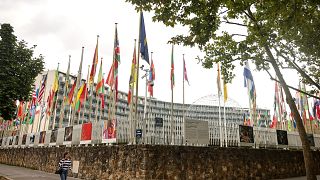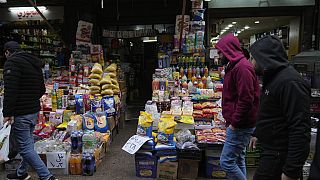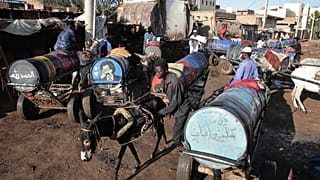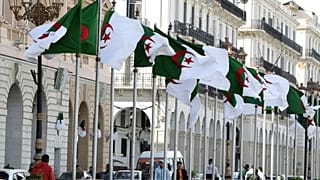Morocco
In a traditional restaurant' kitchen in Rabat, a chef garnishes sweet pumpkin paste made from pumpkin cooked with honey, cinnamon, butter, and orange blossom water, with carefully roasted almond flakes.
In a side bowl, a simple Moroccan salad is prepared, made from tomatoes, cucumbers, onions, and parsley, cut into small cubes and garnished with salted oil-cured black olives. This is one of the most consumed salads in Morocco.
Preparations continue at the traditional Zyriab restaurant, where the chef is putting the finishing touches on hot and cold appetizers, amidst an atmosphere filled with the aromas of Moroccan spices and flavours.
Each Moroccan city is famous for its own specialty, reflecting the diversity of the local cuisine and its connection to the country's cultural and social identity.
"Each city is known for its dish, for example, bastilla from Fez, tanjia from Marrakech which is cooked in clay, and beef tagine with prunes and caramelized apricots from Rabat. Moroccan cuisine is also characterized by its nutritional balance," explains Amine El Boujadi, a specialist and researcher in Moroccan cuisine.
At one of the tables, the waiters serve a selection of appetizers to a customer seated next to Amine El Boujadi, a cuisine specialist.
The dishes begin to arrive one by one, reflecting a variety of flavours and textures. The customer takes a bite of an appetizer, savouring the balance of ingredients and spices.
Chefs prepared a Moroccan tagine dish with chicken, olives, and preserved lemon, which is served after being put in a silver pot. The dish is placed in front of the customer, with tender chicken immersed in a rich sauce appearing in the centre.
While the ingredients are important, the secret to Moroccan flavour lies in the way the spices are handled and the chef's mastery of the various stages of cooking.
"Moroccan cuisine depends heavily on the skills of the Moroccan cook, as it relies on a set of techniques that help give each dish its unique flavour," says El Boujadi.
50 kilometres from the capital, under a simple tent in the village of Brachoua, a group of visitors gather around a traditional breakfast table.
A man fills cups of mint tea, customers are enjoying the sweet and refreshing taste.
The table is filled with a variety of traditional bread, Moroccan pancakes such as meloui, harcha, and batbout, along with honey, dates, natural butter, organic eggs, and black olives.
Among the ingredients that distinguish the Moroccan breakfast table is its reliance on local products prepared using traditional methods, free of any artificial additives or preservatives.
Aicha Sellahi, is president of the association "Ahl Al-Sahra for Development" in Brachoua village and has partnership with the food cooperative "Golden Sands" in the same village.
"The Moroccan breakfast table consists of natural and traditional ingredients such as tea, Moroccan pancake, natural butter, pure honey, and bread that is baked in a traditional oven," she says.
Naima El Meziane, president of the food cooperative "Golden sands" in Brachoua village, removes bread from a traditional oven.
The loaves have risen, revealing perfect, golden crusts.
Traditional bread is characterized by its lightness and high nutritional value, a result of ancient recipes passed down through generations.
"When we knead the bread, we add natural yeast and use wheat and barley flour, which are rich in fibres. This is what distinguishes traditional bread from the bread sold in bakeries, it is healthier due to the fibres and natural yeast," explains El Meziane.
In the same cooperative, cook Laila El Harmaoui begins preparing a dish called "rfissa".
She puts organic chickens in a pressure cooker with sliced onions, later adding lentils and fenugreek seeds.
Whole garlic cloves are added with homemade ghee, while another woman hand-cuts the "meloui," a popular layered flatbread which is an important accompaniment to this dish.
Rfissa, like tagine, is cooked over charcoal and retains its nutritional value thanks to natural ingredients and slow cooking.
Couscous is prepared in a large pot, where the chicken is cooked with a mixture of onions, tomatoes, spices, and olive oil. Vegetables such as carrots, squash, and zucchini are then added.
Tagine is one of the most popular dishes in Morocco and can be prepared in various ways depending on taste and region.
"The most famous dish is the tagine because it is cooked in a clay pot. It is also healthy. It can be prepared with prunes, or onions and raisins, or with olives. It can also be made entirely with vegetables, and it is considered healthy as it is cooked over charcoal," says El Harmaoui.
An old woman begins preparing the beef tagine with prunes, adding spices, garlic, and onions before leaving it to cook over low heat.
The tagine creates a rich, sweet and savoury sauce, a dish often popular for special occasions.
On April 21, 2025, Morocco launched the national consultation process for a UNESCO project aiming for the first time to publish an International Atlas of Food Heritage, as well as a digital platform aiming to preserve, promote and popularise these heritage foods for future generations.
Morocco is among the countries selected for the pilot phase of the project.
The publication of the first version of the Atlas is set for the end of 2027.
According to UNESCO, traditional food isn't just about what we eat.
The UN organisation says it contributes to the development of a country like Morocco's economic and cultural life.
It encompasses farming, fishing, culinary techniques and skills, as well as sustainable food production, such as seed diversity and ecosystem preservation.
"The news of the partnership between Morocco and UNESCO regarding the Atlas International Project made us very happy, because preserving Moroccan cuisine, its skills, techniques, and dishes is a very positive step," says El Boujadi.
Visitors gather under the tent for a lunch feast, including beef tagine with prunes, rfissa, and couscous.
The bread is cut and hands are extended for the main dishes in the traditional manner.
Despite Moroccans' interest in tasting foods from other cultures, local dishes still hold their own, says customer Naima Metrab.
"The uniqueness of Moroccan cuisine remains special. We notice that foreigners, especially tourists, are passionate about tasting Moroccan dishes such as tagine, couscous, or rfissa," she says.
Morocco is also renowned for its street food.
In Jemaa El-Fna, the main square and marketplace of Marrakesh's old medina, visitors gather to sample street dishes such as snails, sheep's heads, and fried fish, reflecting yet another aspect of Morocco's extraordinary cuisine.












Go to video
An equestrian festival in a western Libyan city goes international
05:00
How Japan’s food tech innovations target global food security challenges
Go to video
Nigeria dumps mother-tongue education - just as Ghana embraces it. Who’s it right?
01:03
Morocco expects bumper olive harvest after years of drought
00:59
UNESCO General Conference elects Egypt's El-Enany as Director-General
01:45
Morocco’s caftan: A cultural jewel on the path to UNESCO recognition